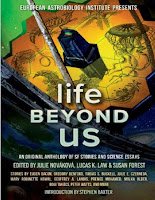It has stories by some of the well-known names of science fiction and is presented by the European Astrobiology Institute (EABI).
What would life be like if it evolved in a cold ocean beneath an impenetrable shell of ice? Or on a world whose haze obscured any view of the universe beyond? Is there a common template for life, or can we expect to find preciously fragile silicon creatures drifting in seas of liquid nitrogen? How would finding alien life change our society?
Life Beyond Us, a new anthology by the European Astrobiology Institute and Laksa Media, depicts the timeless quest for finding alien life in 27 science fiction stories and 27 science essays, aiming to imagine, inspire and illuminate.
I loved reading this book and would like to share some of its aspects which I found illuminating.
Science in the Science Fiction
SF is based on science and is different from fantasy. In SF writers can imagine the future or distant worlds, but they do so based on science or on scientific hypothesis.
However,understanding the science behind each SF story is not easy because it can come from different and specialised fields of expertise, from technology to physics to chemistry to medicine and innovation. I loved this book mainly because each story is followed by an essay which discusses the basic science behind that story. I loved some of the stories, but I loved even more some of the essays explaining those stories because they made me think in unexpected directions.
Below are some examples of the information in the essays which were new for me and which made me think.
Safety of Humans and All Aliens
Giovanni Poggiali in his essay about a SF story by Erik Choi wrote about the fears of humans to make sure that we don't import alien life forms to earth because we may not have immunity against them and they can decimate human and/or animal life. This is something we all understand.
However, I had never thought about the vulnerability of aliens to the pathogens from earth. When we send space-ships to moon or mars or to some other star outside our solar system, is there a danger that some of our bacteria or virus can go with them, and then infest and kill the alien life forms?
Poggiali's essay about ensuring the safety of all life forms on earth and on other planets, made me think about the difficulties of limiting contacts with our bacteria and viruses. We can't sterilise our intestines, also because our gut organisms are fundamental for our well-being and survival. In the long-term colonisation of other planets, I am not sure how this would play out.
Star-Forming Cocoons
Stefano Sandrelli in his essay about a SF story written by Renan Bernardo, talks of an astromical discovery by Bart Bok and Emily Reily in 1940s about a small black cloud which they called globule. They proposed that new stars were being formed inside that globule.
Sandrelli talks about Bok Globules to explain that the space is not empty and that approximately 2% of the total mass of our galaxy, the Milky Way, consists of low-density matter, mostly as a gas, called the interstellar medium (ISM). ISM is 91% Hydrogen and 8.9% Helium. However, 1% of ISM is made up of dust. I have always thought of space as being empty and this information was very unexpected.
Titan, Saturn's Moon
The essay by Fabien Klenner about a SF story by G. David Nordley explains that Titan is an iceball, with a thick atmosphere (4 times as dense as earth's atmosphere) and very low gravity (around 14% of earth's gravity). This information has been used to plan a Dragonfly mission to Titan in 2027 which should reach its destination in 2034.
On earth we have carbon-based life which needs water as a solvent. Titan does not have the conditions for a carbon-based life but it may have conditions for a nitrogen-based (azotosome) life.
Can azotosome based molecules create life and what kind of life it would be, is a tentalising question.
A Really Hot Venus
Sanjay is the hero of the SF story by Geoffrey A. Landis, who wants to go down from his space-ship to visit Venus. Dennis Honing, in his essay about this story explains that Venus is so hot that it cannot host earth-like life. It is hot because it is closer to sun and because it has a lot of CO2, a greenhouse gas.
He explains that on earth the long-term maintenance of climate is due to the carbonate-silicate cycle. CO2 in the atmosphere is dissolved in rainwater, forms carbonic acid, which interacts with silicate minerals. Its product, calcium carbonate, is deposited on earth in areas where tectonic plates converge. As it reaches earth’s interior, those carbonate sediments melt and CO2 is released back into the atmosphere. A main requirement for the whole cycle is the presence of liquid water on earth's surface.
I had read about acid-rain but it was the first time that I was reading about CO2 cycle and wondering if carbonic acid contributes to acid rain? Does this carbonic acid go into water bodies such as lakes and rivers? What impact does it have on the climate? It was a chapter, which left me with a lot of questions.
In Conclusion
The above are some examples of reflections and questions induced by the scientific essays in this book, written mostly by young European scientists. It was a long time that I had read a book like this one, which surprised me so much and made me stop and think so often!
If you like reading science fiction and are generally interested in science, this is the book for you.
*****
#sciencefiction #science #bookreviews #europeanscientists #anthologyofsciencefiction







No comments:
Post a Comment
Thanks for visiting Arre Kya Baat Hai and for your comment! Please use a civilised language. Comments with embedded links are removed.